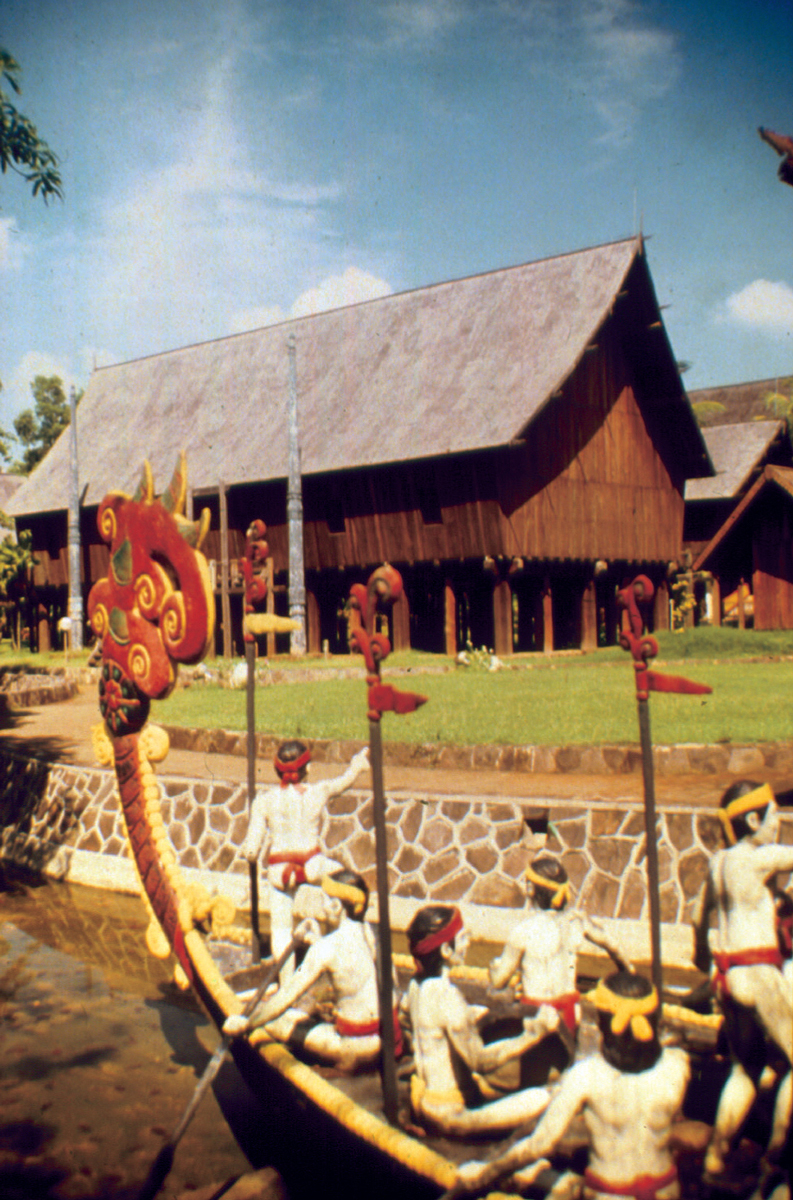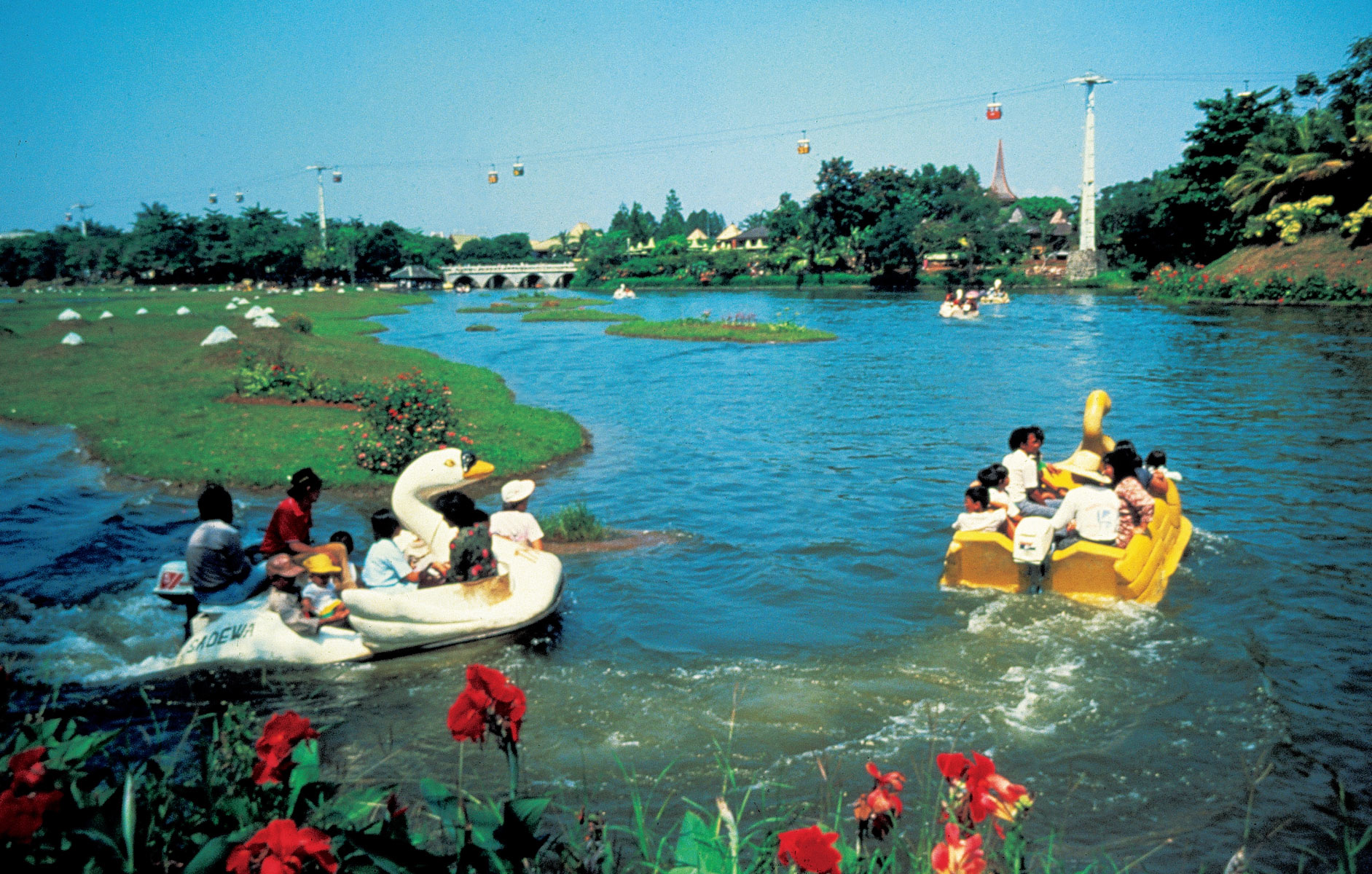Beautiful Indonesia (In Miniature)
The Suhartos’ theme park travesty
David Womack
On a rainy day in November, at the Beautiful Indonesia in Miniature Park, two nearly-naked men from Irian Jaya (the Indonesian half of the island of New Guinea) sit on the cold marble floor in the main pavilion. Their dark faces are streaked with red and yellow ochre. Crescent-shaped bones hang from their noses. They sit with their long, banded arms wrapped around their knees, smoking cigarettes and arguing. In front of them a Balinese dancer stares wide eyed into the middle distance. Without turning her head she looks from right to left to right. Her forefingers flutter like hummingbirds, beating quadruple time to the rhythm of the gamelan. These performances are one of the few things in Indonesia that always take place on time, whether anyone is there to see them or not. As long as they continue, culture is alive and well in Indonesia—or at least that is the official position.
Beautiful Indonesia in Miniature Park, or “Taman Mini” as it is known in Indonesia’s national language, Bahasa, lies six kilometers outside of the capital city, Jakarta. On a weekday afternoon, particularly during the rainy season, the 250-acre park is one of the best places in the Jakarta area for a leisurely stroll. On a sunny weekend, however, the park can be thronged with visitors. Taman Mini draws an estimated 4.5 million visitors a year, the vast majority of them Indonesian. Visitors come to Taman Mini from all over the Indonesian archipelago, which stretches across an expanse of ocean slightly larger than the continental United States. The park features a lake that symbolizes this vast expanse of ocean with islands that represent a few dozen of the archipelago’s 13,677. The islands in the lake are identically flat, featureless, with low bushes representing mountain ranges, and are best viewed from above in a creaky gondola that dangles from a sagging cable. From the gondola, one can also see most of the pavilions that are the park’s main attractions. There is a pavilion for each of Indonesia’s 26 provinces, and one for East Timor, which has just gained independence after a 23-year struggle for independence.
The pavilions were built by traditional craftsmen brought in from the provinces by the government. The Minangkabau pavilion, representing western Sumatra, has soaring, overlapping roofs made of coconut-fiber thatch. The walls are intricately carved and painted with symbols. Taman Mini’s guides—teenage boys who freelance for tips and a chance to practice their English—are particularly proud of the fact that the pavilions are authentic, or “asli.” They were built with all the rituals and ceremonies necessary to insure that they are fully endowed as spiritual, as well as material, entities. The pavilions are not replicas of existing buildings, rather were designed to be exemplary structures—larger and more intricate than any other traditional buildings in Indonesia. Some, such as the Javanese pavilion built in the style of the Kraton, are even considered sacred. The pavilions, and the ceremonies and rituals that take place within them, are meant to exemplify local tradition purified and elevated to the national level.
Taman Mini is beginning to show signs of wear since its benefactors, the Suhartos, were ousted in 1998. The concrete paths have cracked and the paint is beginning to peel off the concession stand. Although widely known among Indonesians, Taman Mini generally receives just a few lines in foreign guidebooks—descriptions that are most often apologetic. They imply that Beautiful Indonesia in Miniature is a place for people who do not have the time or resources to go to the islands themselves. This is not the view that most Indonesians have of the park and is certainly not the government’s position. During Suharto’s 30-year rule, Taman Mini was seen as Indonesia’s most significant cultural symbol. Despite its current disrepair, the park and the policies it represents continue to shape Indonesia today.
The idea for Taman Mini came to the dictator’s wife, Tien Suharto, during a visit to Disneyland on a sunny day in 1971. Tien was said to have been completely smitten with the Magic Kingdom. Perhaps this was because her life had the elements of a fairy tale, though with none of the easy moral lessons. Tien, who traced her lineage back to Javanese royalty, had married below her class. Her husband—who would go on to rule a nation that included pirates, witches and cannibals—was from a poor family. A short man with a blunt nose and pockmarked face, Suharto had risen through the military and had come to power as the result of a coup in which he is rumored to have had his rivals murdered in their beds. Tien was his muse and constant companion and is said by some to have been the brains behind Suharto’s brawn.

The most remarkable thing about Taman Mini is that it was built at all. Taman Mini cost $25 million—a preposterous amount of money in Indonesia in 1971. A group of officials objected to the project, pointing out that for the same price the government could build 52 small industries or seven large universities. Public protests drew large crowds and reached a climax when the “Save Our People’s Money” movement marched on Tien’s “Our Hope” foundation. The army opened fire with live ammunition and at least four people were seriously wounded. Suharto finished the clash with characteristic subtlety, saying of the dissenters, “Quite frankly, I’ll deal with them. No matter who they are!”[1]
Why would the leader of a struggling republic risk public outrage and financial ruin to build a theme park his wife dreamed up at Disneyland? Suharto himself addressed the question at the dedication on 20 April 1975. “Life,” he said, “will not have a beautiful and deep meaning with material sufficiency only… One’s life will be calm and complete only when it is accompanied by a spiritual welfare. The direction and guidance toward that spiritual welfare is, in fact, already in our possession; it lies in our beautiful and noble national cultural inheritance.”[2]This remark gives a clue as to the true function Taman Mini would come to serve for the government. Beautiful Indonesia in Miniature Park was not built to be an amusing diversion. Rather, it would serve as the nation’s spiritual treasure trove—a locked box containing the nation’s cultural wealth to be kept close to Indonesia’s heart and its capital. Suharto’s definition of culture would be elucidated by the festivities that followed.
In addition to the foreign dignitaries, the governors of Indonesia’s territories were recalled to Jakarta for Taman Mini’s dedication ceremony. As the representative of the cultures of that region, each of the governors were required by Suharto to dress in a customary costume. Under these orders, the governor of Irian Jaya wore a fur crown and put a bone through his nose. (This, of course, hardly obscured the fact that he was not a dark-skinned native of Irian Jaya, but a light-skinned Javanese.) The other governors, who were similarly costumed, were Javanese as well. Though the effect of all these pale, pudgy Javanese bureaucrats dressed up like jungle warriors must have been comical, it seems safe say that, given the pious tone of the proceedings, no one laughed—except, perhaps, for Suharto himself. For Suharto, the masquerade was an ideological victory with far-reaching implications. He had succeeded in separating the idea of culture from the people who practiced it. Culture was now a costume that could be taken on or off, depending on the occasion.

Suharto would soon drop his mask. Having secured his position as a champion of culture in Indonesia, he would seize the land and resources of the outer islands and set about to dilute and destroy the people whose culture he had so recently celebrated. These policies would cost hundreds of thousands of lives and fuel the violent separatist movements that now threaten to break Indonesia apart. By the time Taman Mini was completed, the national government had already begun to claim locally held property. The Forest Development Law removed control of the nation’s forests from the communities and gave it to the national government. The results were devastating. In 1966, when Suharto took power, 75 percent of Indonesia, or 144 million hectares, were covered in forest. By the time Suharto was removed from power in 1998, only 53 million hectares, or 37 percent, of the land remained forested. Indonesia had lost its rain forest at more than twice the world average. Suharto pushed the government authority into the most isolated regions of Sumatra, Sulawesi, Kalimantan and Irian Jaya. Huge camps were created in the middle of the jungle. Workers were brought in from Java and Madura. The money went to Jakarta. Tien Suharto even earned the nickname “Mrs. Ten Percent” because of the cut she took on business deals. When Suharto left office his successor estimated his fortune at $45 billion—enough to repay Indonesia’s debts to the International Monetary Fund and the World Bank. Taman Mini and the cultural policies it represented had paid for themselves many times over.
Suharto’s policies brought equal devastation upon the people. Hundreds of thousands of people who resisted the authority of the Indonesian government were tortured and killed in East Timor, Irian Jaya, Aceh, and elsewhere. Recognizing that culture, though officially entombed at Taman Mini, might still be an organizing force, Suharto pushed a policy designed to dilute these populations. The program was called transmigrasi. Transmigrasi consisted of moving people from the densely populated islands such as Java to the outer islands. As many as 3.5 million people were lured by the promise of free land and housing but in fact found themselves stranded in isolated communities consisting of tiny, tin-roofed houses laid down at the edge of the jungle. Like canaries in a coalmine, the immigrants were used to inform the government of local hostility. When the hostility reached the boiling point, they would let the government know by dying.
The participants in transmigrasi have been the victims of some of the most extreme ethnic violence. On one island alone, Kalimantan, members of the Dyak ethnic group—the famed “Wild men of Borneo”—have slaughtered more than 550 immigrants in numerous attacks. Claiming a revival of ancient headhunting practices, they leave the headless corpses of men, women, and children strewn about the dirt streets. Although they seem to fancy themselves warriors descending from the forest primeval, they are several decades too late for that. In reality, most of these killers lived a life that was remarkably close to their victims–struggling to eke a living from a land that had been reduced to red dirt and saw grass.
In May of last year, the Beautiful Indonesia in Miniature Park held a mock Dyak wedding. At more or less the same time, the Dyaks held a mass execution in Kalimantan. Both of these events were seen as a celebration of Dyak culture by the people who staged them. Neither has much to do with the hunters and gatherers who once lived in the world’s second largest rain forest and developed a complex system of rituals and beliefs that were in harmony with a world that has now almost entirely vanished. Beautiful Indonesia in Miniature has overtaken beautiful Indonesia.
- John Pemberton, On the Subject of Java (Ithaca: Cornell University Press, 1994), pp. 157-158.
- Ibid.
David Womack was a Darmasiswa scholar in Indonesian literature and Javanese language at the Universitas Gadjah Mada in Yogyakarta, Java.
He is currently the director of new media at the American Institute of Graphic Arts.